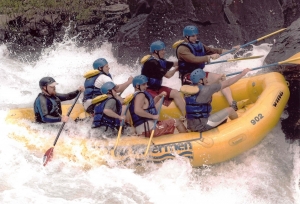By: Andrew Kilpinen
Today in American Whitewater v. Thomas Tidwell, the 4th Circuit affirmed the decision of the district court for the District of South Carolina that rejected challenges to the Forest Service’s revised management plan that allowed “floating” on a 21-mile stretch of the Chattooga River.
2012 Forest Service Management Plan Opened Portion of 21-Mile Stretch to Floating Activities For First Time Since 1974.
Congress designated the Chattooga River (“River”) for preservation in 1974. Since then, the Forest Service has prohibited “floating,” non-motored boating, on the 21-mile northernmost section of the River (“Headwaters”). In a Solomonic compromise seeking to weigh the interests of fisherman, property owners, and floaters alike, the Forest Service revised its management plan in 2012 to allow floating on most of the Headwaters during select winter months. As is often the case with compromises, no one was satisfied with the outcome – lawsuits followed.
Did the Forest Service Violate Federal Law When it Opened Portions of the Chattooga River for Floating?
Kayaking, canoeing, and whitewater rafting enthusiast not-for-profit American Whitewater (“Whitewater”), upset that the entire Headwaters were not opened for floating, alleged the Forest Service violated the Administrative Procedure Act (“APA”) and the Wild and Scenic Rivers Act (“WSRA”).
Property owners (“Rusts”) and environmental not-for-profit Georgia ForestWatch (“ForestWatch”), upset that the Forest Service opened any of the Headwaters to floaters, alleged that the Forest Service violated the National Environmental Policy Act (“NEPA”) when it failed to complete a sufficient risk analysis for the 2012 management plan.
Forest Service Did Not Violate the WRSA.
Whitewater argues that remaining restrictions violate WRSA because floating was an outstandingly remarkable value (“ORV”) that led Congress to designate Chattooga River for preservation. The WRSA provides that Forest Service must “protect and enhance” all ORVs. Therefore, limited floating to any portion of the River violated the WRSA.
The Court did not agree. The Court found that the River’s ORV was its recreational activities in general, and not a single activity such as floating. Consequently, floating is not an independent ORV of the River that must be protected and enhanced under the WRSA.
Floating Is Public Use And Could Substantially Interfere With Other Uses.
Whitewater argues that floating cannot be limited because it does not “substantially interfere” with any protected use of the Headwaters. The Court pointed out that floating is a “public use,” and is therefore not entitled to the “substantial interference standard” protection. Even if it was, the Court noted that the record supported the Forest Service’s conclusion that floating could interfere with other recreational uses.
Rusts Complaint Moot Because Forest Service Has Never Opened Land-Adjacent Stretch.
Rusts sought declaratory judgment that the 1.7 mile portion of the Headwaters running through their land was non-navigable private property. The Court refused to render a decision on the issue and dismissed the Rusts’ declaratory judgment because the Forest Service never attempted to open the waterway adjacent to their property.
Potential Illegal Trespass Over Rusts’ Property Not Reasonably Foreseeable.
Fearing an influx of kayakers traipsing through their backyard, the Rusts argued that the Forest Service violated NEPA because they failed to provide a sufficiently detailed analysis of the risk of illegal trespass. In support for their position, the Rusts offered the account of a man who trespassed over their property 40 years earlier and a stray newspaper report.
The Court recognized that the Forest Service was only required to analyze “reasonably foreseeable” effects of its decisions. The Court found that a possible spike in trespass across the Rusts land was too speculative to meet this standard.
The 4th Circuit affirmed the district court’s ruling affirming the Forest Service management plan for the Chattooga River.






